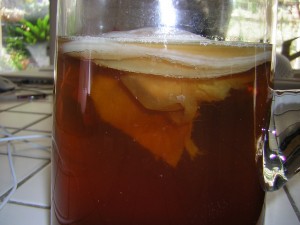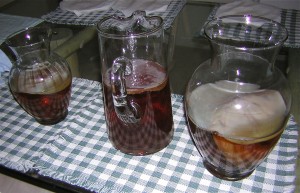Kombucha tea is the product of fermentation by a ‘Symbiotic Culture Of Bacteria and Yeast’, aka SCOBY’, in sweetened tea. The tea is as sweet as you allow it to be based on how long you ferment it and it has a nice fizz. Below is a picture of one of my SCOBYs. The culture grows in layers with the newer ones growing on top.
Although both yeast and bacteria require nitrogen and oxygen to survive they consume different elements during the fermentation process created by their symbiotic existence.
In very simple terms, the yeast turns the sugar into alcohol. Then the ‘good’ bacteria turns the alcohol into acetic acid which is the main ingredient in vinegar. The ‘good’ bacteria next consumes the sugar, and then the caffeine in the tea as each element is exhausted. This combination of alcohol and acetic acid makes the culture resistant to most ‘bad’ airborne bacteria or molds.
There is anecdotal evidence that kombucha tea has many health benefits, from detoxing to aiding in recovery and increasing energy, as well as many others. However, it has been very difficult to verify these claims due to the many differing strains of cultures available. Kombucha tea is commercially available but can be easily made at home with a healthy SCOBY and sweetened tea.
I keep a ‘SCOBY hotel’ which is a mini collection of separate cultures, some of which are used for my own consumption and others that are for sale.
A fermentation period of 11 days is optimum for a first ferment, in my opinion. A first ferment utilizes the SCOBY to produce the starter tea. A second ferment can be done by removing the SCOBY and adding fruit juices and other ingredients according to personal taste. My favorite recipe includes white grape juice, dried hibiscus flowers and ginger.
Below is a list of some of the bacteria and yeast contained in kombucha:
Bacterium gluconicum
Bacterium xylinum
Acetobacter xylinum
Acetobacter xylinoides
Acetobacter Ketogenum
Saccharomycodes ludwigii
Saccharomycodes apiculatus
Schizosaccharomyces pombe
Zygosaccharomyes
Saccharomyces cerevisiae
Acetic acid
Acetoacetic acid
Benzoic acid
propenyl ester
Benzonitrile
Butanoic acid
Caffeine
Citric acid
Cyanocobalamin
Decanoic acid
Ethyl Acetate
Fructose
d-Gluconic acid
Glucose
Hexanoic acid
Itaconic acid
2-Keto-gluconic acid
5-Keto-gluconic acid
2-Keto-3-deoxy-gluconic Lactic acid
Niacinamide
Nicotinic acid
Pantothenic acid
Phenethyl Alcohol
Phenol, 4-ethyl
6-Phospho gluconate
Propionic acid
Octanoic acid
Oxalic acid
Riboflavin
d-Saccharic acid
(Glucaric acid)
Succinic acid
Thiamin
plus 40 other acid esters in trace amounts
I hope this gives you enough information to get you started brewing your own tea or at least motivates you to further research the subject. We can all control what we consume and therefore, the impact it has on our bodies.
To your health!

